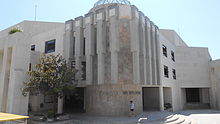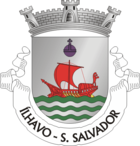Ílhavo
| Ílhavo | ||||||
|---|---|---|---|---|---|---|
|
||||||
| Basic data | ||||||
| Region : | Centro | |||||
| Sub-region : | Aveiro Region | |||||
| District : | Aveiro | |||||
| Concelho : | Ílhavo | |||||
| Coordinates : | 40 ° 36 ′ N , 8 ° 40 ′ W | |||||
| Residents: | 16,598 (as of June 30, 2011) | |||||
| Surface: | 42.17 km² (as of January 1, 2010) | |||||
| Population density : | 394 inhabitants per km² | |||||
| Postal code : | 3830 | |||||
| politics | ||||||
| Mayor : | Rufino Filipe | |||||
| Address of the municipal administration: | Junta de Freguesia de Ílhavo R. Dr. Frederico Cerveira 3830-196 Ílhavo |
|||||
| Website: | www.jf-ssalvador.pt | |||||
| Ílhavo district | ||||||
|
||||||
| Residents: | 38,598 (as of June 30, 2011) | |||||
| Surface: | 73.47 km² (as of January 1, 2010) | |||||
| Population density : | 525 inhabitants per km² | |||||
| Number of municipalities : | 4th | |||||
| administration | ||||||
| Administration address: | Câmara Municipal de Ílhavo Av. 25 de April 3830-044 Ílhavo |
|||||
| President of the Câmara Municipal: | José Agostinho Ribau Esteves ( PSD ) | |||||
| Website: | www.cm-ilhavo.pt | |||||
Ílhavo is a city ( Cidade ) and a district ( Concelho ) in Portugal . It is located in the Aveiro district , in the north of the Centro region .
history
Ílhavo's history is closely linked to the sea. Probably from 1372 BC. Chr. The first time Phoenicians , Greeks and probably northern European Sea Peoples in the mouth of the Rio Vouga sailed in and there are the first settlements established. Later Romans also frequented this place . For their part, the fishermen of Ílhavo are considered to be the founders of various localities (e.g. Cova-Gala near Figueira da Foz ). The current place name appears for the first time as villa iliauo in writings from the Sé Cathedral of Coimbra , which date from the years 1037 to 1065, after the final reconquest from the Moors .
There are no documents about the exact establishment of the Ílhavo County. It already existed in 1095. The city was first granted city rights (Foral) by King D Dinis in 1296.
In 1824 the Vista-Alegre -Manufaktur was founded here, which became famous for its glass and porcelain production. In the course of the various administrative reforms after the Liberal Revolution in 1822 , the independent Ílhavo district was confirmed in 1836, but dissolved in 1895 despite protests from its citizens and joined to Aveiro. After constant efforts, the district was restored in 1898.
As a result of its development, the previous small town ( Vila ) Ílhavo was elevated to a city ( Cidade ) in 1990 . In 2001 Gafanha da Nazaré also became a town, but remained a municipality in the Ílhavo district.
Culture and sights
The nationally and internationally best known attraction for visitors is the museum and the historical factory area of the Vista Alegre porcelain factory. The sandy beaches are also a major attraction, especially on the Costa Nova with the characteristic colorful wooden houses.
Ilhavo part of the speech Nacional de Arte Nova Município , a grouping of locations in Portugal, by particularly numerous and striking buildings of the Art Nouveau ( port. Arte Nova) excel. The most famous examples in Ílhavo include various town villas, such as the ornate Villa Africana .
The Museu Marítimo de Ílhavo is dedicated to the regional fishing and marine history. The last completely preserved towing vessel of the stockfish fishing fleet can be seen there.
Historically, arte xávega was an important form of fishing all along the Portuguese coast, and particularly in the local region. Nets were brought from the beach to the sea and pulled ashore with the help of ox carts. Even today this species is occasionally practiced here and is considered a tourist attraction.
administration
Ílhavo district
Ílhavo is the seat of a district of the same name. The neighboring districts are (starting clockwise in the north) Aveiro and Vagos . The circle is split into three parts by the arms of the Ria de Aveiro . The following municipalities ( freguesias ) are in Ílhavo County:
| local community | Population (2011) |
Area km² |
Density of population / km² |
LAU code |
|---|---|---|---|---|
| Gafanha da Encarnação | 5,362 | 10.98 | 488 | 011005 |
| Gafanha da Nazaré | 15,240 | 16.44 | 927 | 011006 |
| Gafanha do Carmo | 1,526 | 7.05 | 216 | 011007 |
| Ílhavo | 16,470 | 39.00 | 422 | 011008 |
| Ílhavo district | 38,598 | 73.47 | 525 | 0110 |

The Ílhavo Town Hall ( Câmara Municipal )
|
Population development
| Population in Ílhavo County (1801–2011) | |||||||||
|---|---|---|---|---|---|---|---|---|---|
| 1801 | 1849 | 1900 | 1930 | 1960 | 1981 | 1991 | 2001 | 2011 | |
| 5436 | 6797 | 13.163 | 17,709 | 25,108 | 31,383 | 33,235 | 37.209 | 38,598 | |
Municipal holiday
- Easter Monday
Town twinning
Ílhavo cultivates town twinning or friendship
-
 Canada : St. John's (Newfoundland)
Canada : St. John's (Newfoundland)
-
 United States : New Bedford (Massachusetts)
United States : New Bedford (Massachusetts)
-
 United States : Newark (New Jersey)
United States : Newark (New Jersey)
-
 Germany : Cuxhaven
Germany : Cuxhaven
-
 Brazil : Paraty
Brazil : Paraty
-
 Bulgaria : Ichtiman
Bulgaria : Ichtiman
-
 Iceland : Grindavík
Iceland : Grindavík
-
 Portugal : Funchal
Portugal : Funchal
sons and daughters of the town
- José António Pereira Bilhano (1801–1890), Bishop of the Archdiocese of Évora
- Alexandre da Conceição (1842–1889), author, poet and literary critic
- Francisco Xavier Esteves (1864–1944), engineer, university professor and politician
- Tomé José de Barros Queirós (1872–1925), politician and briefly Prime Minister of the country in 1921.
- Manuel Trindade Salgueiro (1898–1965), Bishop of the Archdiocese of Évora
- Euclides Vaz (1916–1991), sculptor
- Mário Castrim (1920–2002), journalist, television critic and writer
- Mário Emílio de Morais Sacramento (1920–1969), writer, doctor and politician
- José Manuel Rolo (* 1941), economist, author and journalist
- António Vieira da Silva (* 1946), medic, poet and musician
- Bagão Félix (* 1948), finance manager and politician, multiple minister
- Viriato Teles (* 1958), journalist and writer
- Duarte Victor (* 1959), actor and theater director
- Joaquim Teles (* 1963), musician
- José Agostinho Ribau Esteves (* 1966), politician
- Teresa Machado (* 1969), athlete
- Jacinta (* 1971), jazz singer
- Catarina Resende (* 1972), journalist and writer
- João Paulo T. Esperança (* 1972), linguist and Tetum translator
- Jorge Cruz (* 1975), musician
Web links
- Map of the Ílhavo Freguesia at the Instituto Geográfico do Exército
- Official website
gallery
Individual evidence
- ↑ www.ine.pt - indicator resident population by place of residence and sex; Decennial in the database of the Instituto Nacional de Estatística
- ↑ a b Overview of code assignments from Freguesias on epp.eurostat.ec.europa.eu
- ↑ www.ine.pt - indicator resident population by place of residence and sex; Decennial in the database of the Instituto Nacional de Estatística
- ↑ History page of the city administration , accessed on August 22, 2013
- ↑ ditto
- ↑ www.verportugal.net , accessed on August 22, 2013
















